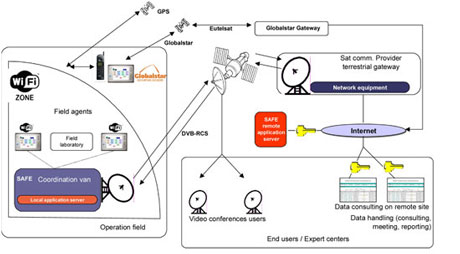by Catherine Chronaki and Laurent Braak
The risk of epidemics and emerging or re-emerging diseases such as avian flu or chikungunya fever is rising. Luckily, these risks can be contained with prevention, early warning, and prompt management. In this context, current early warning and response systems, although well-developed in Europe, could benefit from satellite services.
Detection and monitoring of potential risks has become an important part of the so-called 'Epidemic Intelligence' as a reaction of surveillance systems to the risk of epidemics arriving from less-developed areas outside Europe. Health early warning systems in areas remote, inaccessible, or prone to natural or man-made disasters enabled by satellite communications can significantly limit the risk of onset and the effects of epidemics and contribute to settling major public health issues. Economically speaking, satellite communications can also save money by enabling rapid and coordinated response and optimal adjustments of resources when deploying an emergency plan.
The SAFE project, co-funded by the European Space Agency (ESA), will develop and demonstrate the added value of satellite communication services, including low and high bandwidth access to Internet, co-operative working and geolocalisation for all phases of biological crisis including prevention, early warning, and crisis management. SAFE aims to establish a roadmap for ESA to determine how satellite services, by enabling or restoring access to information, can be integrated in European healthcare systems and civil protection authorities.
The SAFE project is part of the ESA telemedicine via satellite transition phase, set up to pave the way for the creation of a European user-driven telemedicine via satellite programme. ESA together with the World Health Organization (WHO) are joining forces for reaching this goal.

ESA through SAFE and with the assistance of WHO will specify, develop, and demonstrate a European outbreak early warning system that will become a key tool for the national and European bodies in charge of epidemiological surveillance and especially the European Center for Disease Control (ECDC). SAFE aims towards a better assessment of the epidemiological risks based on real-time objective data, which is a strategic objective not only for public health policy, but also for the eHealth industry. The SAFE solution that will be marketed to the different actors of epidemiological surveillance comprises the following components:
-
a network of expert centers and hospitals able to communicate by satellite, and interoperable with other networks (eg gateways to Galileo and GMES-RESPOND);
-
a coordination van equipped with a DVB-RCS capability and Internet access for communication with decision makers and expert centers. It has the role of the local coordination centre. Communication between the local coordinator and the mobile teams on the field will be ensured via a local Wi-Fi network and Satellite phones outside the Wi-Fi coverage. Mobile teams will be equipped with handheld terminals for data collection;
-
a field laboratory or lab kit equipped with biological and biomedical equipment will identify microbial agents responsible for the threats to enable in-situ analysis;
-
a SAFE information system including a data collection sub-system and a GIS. Besides geolocalisation, the GIS will enable visualizing the evolution of the epidemic and monitoring the alarm levels associated with the different geographical regions. This system will be based on relevant standards and will be interoperable with existing information systems, ie national health information system, deployable emergency response information system, epidemiological information systems and others. It will facilitate monitoring of indicators and other measures potentially useful in modeling the transmission patterns. Dissemination of this data can be done with the Internet capability via satellite.
An end-to-end case of early warning at the onset of an epidemic will be demonstrated at the Heraklion prefecture, in the island of Crete, Greece. The scenario based on epidemiological monitoring after an earthquake, namely the onset of typhoid fever epidemic, will validate the SAFE approach within the user community and if successful it could become part of regular earthquake readiness exercises. Furthermore, other demonstrations will be envisaged and implemented, namely related to avian flu and biological and radiological threats. These itinerant and on-demand demonstrations will be implemented all over Europe upon user request, promoting the added value of SAFE and allowing potential end-users and stakeholders to assess the demonstration according to relevant criteria, such as availability, interoperability, and security.
The SAFE consortium of nine partners from four countries is coordinated by MEDES (Institute for Space Medicine and Psychology, France). End users are represented by two epidemiology institutes - ISCIII (CNE) Instituto de Salud Carlos III 'Centro National de Epidemiologia' (Spain) and InVS 'Institut de Veille Sanitaire' (France) - to ensure compliance with policies and practices of epidemiological monitoring. ICS-FORTH (Greece) coordinates the demonstration of post-disaster biological risk monitoring in Crete. MICRO-UNIVr (University of Verona, Italy) is responsible for the mobile lab equipment and definitive identification of the microbial agent causing the biological crisis. MEDIVAN (Italy) provides industrial expertise on marketing mobile units for medical emergencies and rescue. GMV (Spain) ensures the overall system design, integration and the development of the GIS. TTSA (France) brings expertise in satellite communications and marketing of satellite services in health. REMIFOR (France) provides the co-ordination van and links with the professional bodies of civil protection and firemen. MEDES (France) co-ordinates the economical analysis and provides recommendations relying on its ongoing activities in epidemiology and humanitarian medicine involving satellite communications.
Links:
European Space Agency: http://www.esa.int
European Center for Disease Control: http://www.ecdc.europa.eu/
World Health Organization: http://www.who.int
Please contact:
Audrey Berthier, MEDES, France (project coordinator):
E-mail: audrey.berthier![]() medes.fr
medes.fr
Pierluigi Mancini, ESA, Directorate of European Union and Industrial programs
(Program manager)
E-mail Pierluigi.Mancini![]() esa.int
esa.int
Catherine Chronaki, ICS-FORTH, Greece
E-mail: chronaki![]() ics.forth.gr
ics.forth.gr










